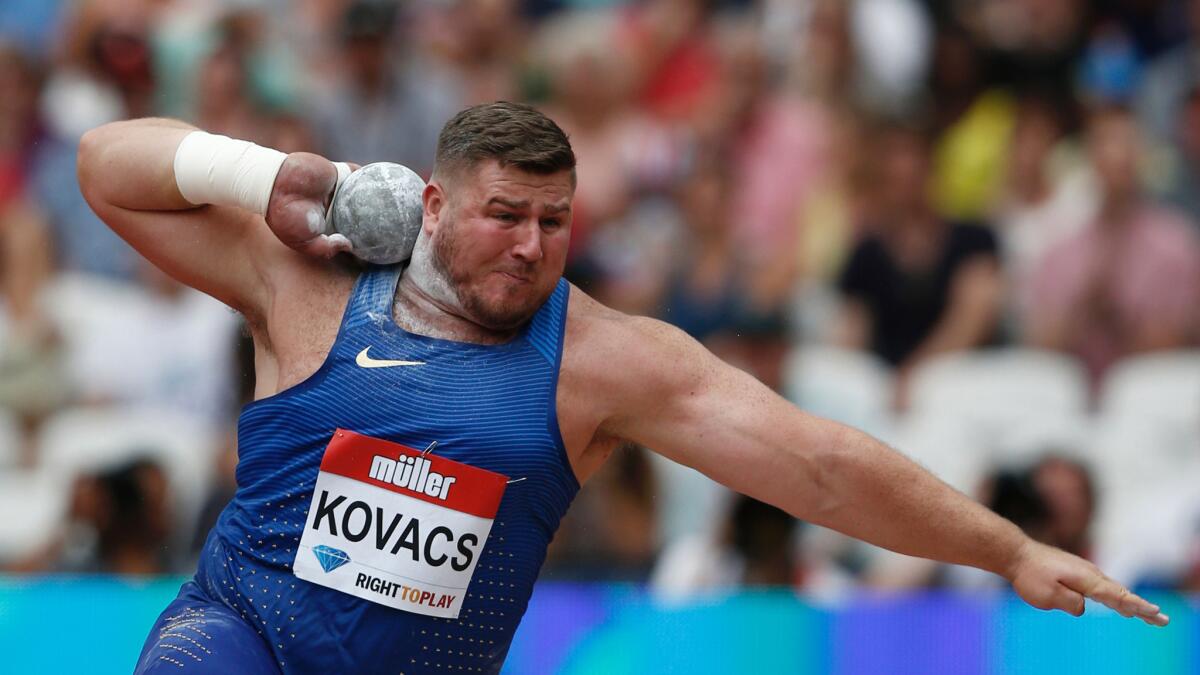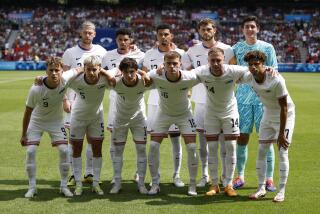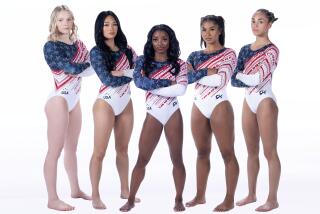Great Read: Olympic shotputter Joe Kovacs learns the sport from a surprise teacher: his mom

The big man had come so close.
If Joe Kovacs had thrown the shotput just a few inches farther, he would have made the 2012 Summer Olympics.
As the fourth-place finisher at the U.S. track and field trials, he settled for the role of alternate, which meant he had to stay ready in case someone got hurt but would probably end up watching the Games from home.
The morning after the trials, officials summoned him to the team processing center.
“They make you get fitted for a uniform you’ll probably never wear,” he said. “You have to try everything on.”
While the athletes who qualified for the American team eagerly collected their gear, the alternates quietly endured the routine.
“It was kind of sad,” he said. “You looked around and could see them crying.”
So why did Kovacs have a grin on his face?
::
Like a lot of Pennsylvania boys, he grew up loving football. Not particularly tall, he was built thick enough to play on the offensive and defensive lines at Bethlehem Catholic High.
When the team was encouraged to stay in shape by running track in spring, Kovacs and the other linemen chose shotput and discus. The problem was, the school had no throwing coach.
“They didn’t even have a track, just a parking lot,” Joe’s mother, Joanna Kovacs-Royer, recalls. “One day I saw the boys out there picking up the shot and I really thought they were going to hurt themselves so I got out of the car and said, ‘Wait.’”
She gave them a few quick pointers — she had been a champion thrower in high school and, besides, helping Joe was a familiar role for her. Seven years earlier, her husband had died of colon cancer and she had put her life on pause to take care of Joe.
“She didn’t date or anything,” Kovacs says.
At Bethlehem Catholic, Joanna volunteered to coach the kids in that parking lot, using chalk to draw a throwing circle on the pavement.
Each afternoon, she taught them the basics of grip, footwork and release. Practicing the shotput was easy because they could throw toward an adjacent patch of grass, but when Kovacs improved, tossing the discus onto a nearby road, something had to change.
Mother and son began holding extra workouts by themselves at another school. Joanna occasionally took him to see outside coaches as he struggled to learn the intricacies of his new sport.
“I was a late bloomer,” he says. “It wasn’t until my senior year, my last meets, that I started having big throws.”
In 2007, he won state titles in shotput and discus, attracting a scholarship offer from nearby Penn State. Football was still his favorite, but the Nittany Lions wanted him for track.
“I told him to go with it,” Joanna says. “It was the smart move.”
“With the shotput, I loved that I could break things down to a science.”
— Joe Kovacs
Saturday football games — with Penn State charging onto the field in those traditional blue and white uniforms — could be tough.
Through his first year in college, Kovacs spoke often with the football coaches and was tempted to switch back. Something kept him hanging around the track.
Always quiet and studious, he had won a string of gold medals in high school science fairs.
“I was the guy trying to figure things out and write down the equation to make it happen,” he says. “With the shotput, I loved that I could break things down to a science.”
Angular velocity. Release height. Throwing the 16-pound ball was more than an act of brute strength — it was a physics equation.
At 5 feet 11, Kovacs needed to outsmart opponents who stood three or four inches taller. While they used size for leverage, he generated power through technique, spinning his body across the seven-foot ring.
Attention to detail made him a solid collegiate thrower, but he wasn’t a standout. As graduation neared, the energy business and finance major began searching for work.
“I was taking interviews and looking forward to that kind of future,” he says.
Then, in what figured to be his final meet, Kovacs threw the shot past 20 meters at the 2012 Big Ten championships, which earned him a trip to the Olympic trials.
His mother came along, watching from the stands as he improved to 21 meters, finishing 20 centimeters short of making the 2012 London Games. She recalls thinking: Well, that was a great track career. Now he can go get a job.
::
Kovacs had no idea what track athletes did after college; he had never given it much thought. At the 2012 trials, he found out.
Agents approached him the moment he stepped off the field. So did a representative from Nike.
“A whole new life opened up,” he says. “I was looking at the opportunity cost of throwing the shotput versus the opportunity of starting a long career in something else.”
That explained his grin at the processing center the next morning. Kovacs headed off to the pro circuit in Europe, where he spent the summer traveling from one meet to the next, before returning home in the fall to look for a coach.
“I knew this was a big step for him,” his mother says. “That’s the way Joey approaches these things — he researches.”
At the top of his list was Art Venegas, who had a history of grooming elite throwers with UCLA and the national team. Kovacs drove out to California.
It seemed like a good fit to both men, but they needed time to mesh.
“Art will admit he’s not a very scientific guy,” Kovacs says. “He tells a lot of stories and his personality is kind of crazy.”
Venegas says: “Joe is quiet and extremely technical but the overthinking, I put an end to that right away. I told him, ‘We’re not in New Mexico building the first atomic bomb.’”
The ground rules were simple: Kovacs did whatever he was told, no questions asked.
::
Their work began with endless spins and footwork drills on a tennis court where Kovacs forced his 293-pound body to move differently.
“There were times I took a tumble,” he says. “Actually, that happened a lot.”
Each week, he reported to a YMCA near his new home at the Olympic training center in Chula Vista, Calif. A gymnastics coach had him flip off a trampoline and land in a foam pit.
“We were trying to create power in ways that throwers never had before,” Venegas says. “Precise movements within the critical moment of velocity.”
Kovacs also trained on the horizontal bar, swinging back and forth until he could execute “giants” — whipping that massive frame 360 degrees around the bar. Venegas says: “It looked ridiculous … like Newtonian physics being defied.”
His agility improved, even if his throwing distances did not. After those heady days the previous summer, Kovacs struggled through the next season with no personal bests, no significant victories.
His mother could tell he had doubts.
“He was calling home a lot,” she says. “That was unusual.”
The thrower kept reminding himself that Venegas had a plan. He watched film of the coach’s previous stars such as former world champion John Godina.
“I had to let Art experiment,” he says. “I had to let him mold me.”
The turning point came in June 2014 when Kovacs threw 22 meters to win the U.S. national title. The following summer, in Beijing, he took gold at the world championships.
::
Troublesome thoughts sneaked into his head during the Olympic trials in Oregon last month.
Midway through the daylong competition, Kovacs glanced up at the stands where his mother sat beside her new husband, Larry. They had already purchased flights to Rio de Janeiro, believing Kovacs would make the team.
“You get a little tighter,” he says. “You realize what’s at stake.”
Unlike 2012, Kovacs did not have a great day, hovering around the 21-meter mark on his first five attempts; as he approached the final throw, his roster spot was still in doubt.
With the crowd starting a rhythmic clap, he spun three times across the ring and released the shot with a bellow. The ball sailed through the air, thudding down just short of 22 meters, putting him safely in second place.
“Definitely a relief,” he says. “With the trials, the biggest thing is just getting through it.”
The next morning, Kovacs reported to a converted ballroom at a local hotel — the U.S. team processing center.
Mannequins dressed in Olympic uniforms stood at the center of the room. There were racks of official clothing, information desks and a photo booth for athletes to take souvenir pictures.
Once again, Kovacs had a smile on his face.
“I was trying to soak everything in,” he says. “It was really fun.”
Even more fun than four years ago.
MORE FROM SUMMER OLYMPICS
Hollywood Park rescue horse finds himself in the Olympics
Tranquil scene at Olympic Park can’t allay fears as opening ceremony approaches
On eve of the Games, Thomas Bach defends IOC over Russian doping crisis
More to Read
Go beyond the scoreboard
Get the latest on L.A.'s teams in the daily Sports Report newsletter.
You may occasionally receive promotional content from the Los Angeles Times.






